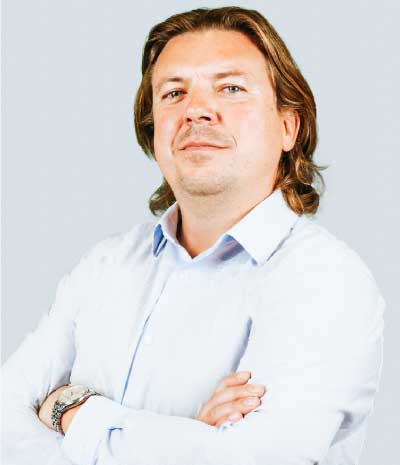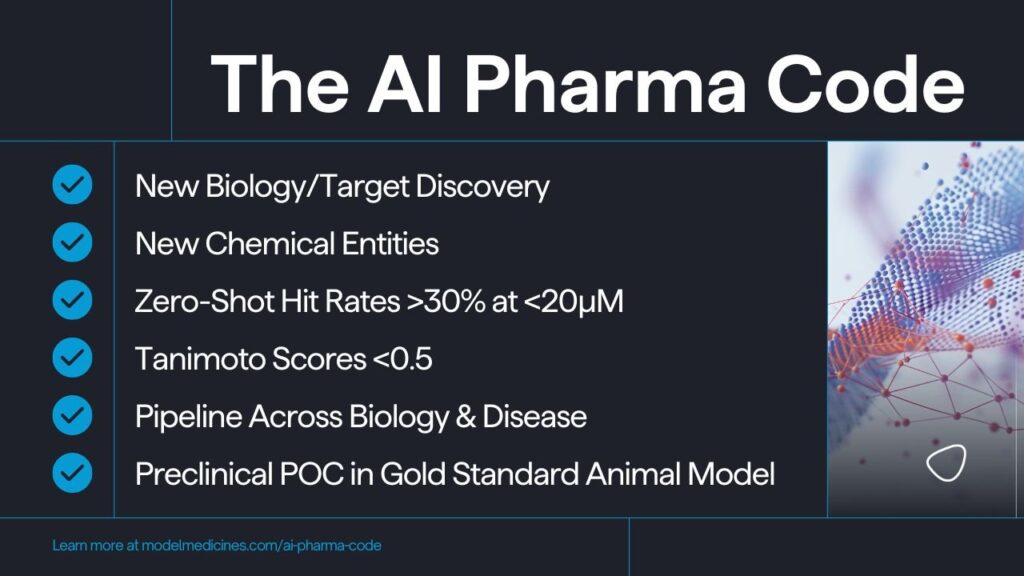
Closely-held Model Medicines is spearheading the use of AI to model chemistry and human biology, empowering drug discovery and creating novel, best-in-class therapeutics for diseases with high unmet medical needs at unprecedented speed.
“By combining AI, machine learning, medicinal chemistry, and biology, our team is laser-focused on unlocking AI’s potential to not merely create thousands of hits that never reach the clinic or pharmacy but to generate real drugs that help real people,” Daniel Haders II, Ph.D., co-founder and CEO of Model Medicines, says in an interview with BioTuesdays.
Using its proprietary GALILEO AI platform, Model Medicines has discovered a growing list of more than 190 viable compounds for 26 targets. These compounds have been validated by multiple world-class academic and corporate laboratories across oncology, infectious diseases, and metabolic disorders.
“The magic of our pipeline starts with data,” Dr. Haders, says. “GALILEO identifies and extracts relevant data from primary literature sources to create ‘Built-for-Purpose’ datasets via advanced pharmacophore modeling and precise, hypothesis-driven data mining techniques. The meticulous contextualization of data enables us to uncover valuable implicit information that is often overlooked by traditional data mining methods.”
Highlighting Model Medicines’ distinctive AI approach that enables the exploration of extensive chemical landscapes and accurate prediction of the most promising compounds, Dr. Haders says the company accelerates the creation of best-in-class therapeutics for high unmet medical needs, ranging from broad-spectrum antivirals to cancer treatments.
Dr. Haders explains that the company’s approach to AI drug discovery was uniquely borne out of a rigorous checklist when he and a colleague were evaluating investment opportunities in the AI drug discovery space. “We developed a set of criteria because we wanted a clear framework for assessing the capabilities and potential of companies in the rapidly evolving AI-driven drug discovery landscape,” he recalls.
Formalized into what is now the company’s AI Pharma Code, Dr. Haders suggests this criteria is poised to become the new industry standard because it can provide a comprehensive measurement of their success in utilizing AI to consistently and rapidly discover and develop more effective and novel drugs for new targets across multiple areas of biology and disease.

Steadfast in walking the talk, Dr. Haders says the Model Medicines multidisciplinary team is delivering on the AI drug promise by innovating at the intersection of data science, biology, and drug development to independently discover truly novel therapeutics that meet high unmet medical needs. He points to their astronomical lead compound hit rates for target undruggable proteins and new drug target proof.
One such target, the RdRp Thumb-1 site, has revolutionized antiviral treatment by facilitating the discovery of a single drug effective against multiple RNA viruses. Model Medicines’ pan-antiviral candidate, MDL-001, an orally bioavailable broad-spectrum inhibitor, was discovered via the GALILEO platform and developed in collaboration with Scripps Research and Icahn School of Medicine at Mount Sinai. Validated in preclinical gold standard animal models at Icahn’s Garcia-Sastre Laboratory, MDL-001 not only targets SARS-CoV2 but has antiviral efficacy against RSV and influenza. “Having a drug that can treat all three major respiratory viruses—COVID, RSV and flu—likely represents a major paradigm shift in the clinical management of these diseases,” Davey Smith, M.D., infectious disease specialist and lead clinical advisor for Model Medicines indicates.
“We have achieved an unprecedented hit rate of 66.7% in discovering new chemical entities that have pan-antiviral activity using our proprietary AI platform,” Dr. Haders says. “These new compounds have demonstrated antiviral properties at low, orally administrable concentrations. This is the first time ever that a single pill has inhibited such a remarkably wide range of viruses.”
Most recently, new data has revealed MDL-001’s potential to also treat some DNA viruses, such as hepatitis B (HBV), according to Dr. Smith. “DNA viruses, such as HBV, have an RNA part to their lifecycle, and that gives us a weakness to exploit with MDL-001,” he says.
Underscoring the extraordinary nature of this breakthrough, Dr. Smith explains that DNA viruses, such as HBV, are permanent—they don’t go away, and patients have to take medication for their entire lives. Currently, the standard of care for HBV consists of very few medications. One such medication is Tenofovir. “When we compared MDL-001 head-to-head with Tenofovir, MDL-001 was shown to be 100 times more potent and demonstrated a 300 times better safety profile,” he notes.
“Our new data look enormously promising for the treatment of HBV, especially since it is more potent at lower doses than the current standard of care and with positive Phase 1 safety testing results, which is half the battle. We believe there is potential here for a therapeutic that could represent the future for the treatment of HBV, and quite possibly other DNA viruses that have an RNA component to their lifecycle, such as HIV, either alone or in combination with the standard of care,” Dr. Smith adds.
In stark contrast to pharmaceutical industry giants with big-ticket global laboratories and multi-billion-dollar capital, Dr. Haders outlines that the Model Medicines business model, inspired by AI and cloud-native companies such as Apple and NVIDIA, is based on owning its proprietary IP and farming-out commodity-based work. “For a young company with less than $15 million raised on a single seed round, we have what I believe to be the most robust pipeline that a pharma company can have, outperforming commercial datasets utilized by strategic global pharmaceutical companies,” he contends.
Since its inception in 2019, Model Medicines has established active programs in oncology, infectious diseases, GI, and neurology. The company also has an in silico program for autoimmune and rare diseases and has brought a drug to pre-clinical proof of concept.
Showcasing its prowess in oncology, earlier this year, Model Medicines nominated the preclinical candidate, MDL-4101, a novel-acting small molecule inhibitor of BRD4, a validated oncology target across multiple cancers, especially aggressive thyroid cancers. Previously, BRD4 was considered undruggable due to challenges in safety and tolerability. “There has been no BRD4 inhibitor to receive regulatory approval to date, underscoring the urgent need for new modalities to effectively target this high-value protein,” Dr. Haders says. Given these results, Model Medicines plans to initiate IND-enabling studies for MDL-4101 and launch a Phase I clinical trial in patients in the near future, he adds.
Recognizing that no one business can revolutionize drug discovery alone, Dr. Haders points out that Model Medicines wants to leverage its technology and expertise in partnership with the world’s leading researchers and scientists to scale a company where GLP-1s are engineered rather than discovered by accident.
“Our team believes that while AI is a powerful tool, it doesn’t always do what it’s supposed to. It needs context. At Model Medicines, we’re challenging the status quo by building advanced AI models that can understand complex biology and chemistry to create better medicines tailored to patients’ needs.”
Dr. Haders emphasizes that the Model Medicines team is committed to elevating human health, adding, “Humanity can’t wait decades, which is why we focus on developing lifesaving drugs in days.”
• • • • •
To connect with Model Medicines or any other companies featured on BioTuesdays, send us an email at editor@biotuesdays.com.







